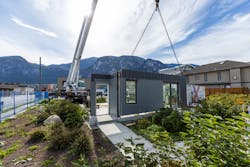What's Nexii? Perhaps the Future of Sustainable Construction
Recently, I had the opportunity to speak with Zosia Brown, PhD, VP of sustainability at Nexii, an innovative Vancouver, BC-based panelized construction provider that is reimagining materials reuse in our industry.
Zosia earned her PhD in Resource Management, Environmental Studies, from the University of British Columbia. She has held leadership positions in sustainability in both the private and nonprofit sectors, and has been with Nexii for nearly a year-and-a-half now. Nexii’s key product is its 8-ft x 32-ft Nexiite construction panel.
The company’s focus is on rapid construction and – when the time comes – rapid and efficient deconstruction. Its vision is to move construction of the built environment from a linear to a circular economic model.
To date, Nexii has successfully used its technology to build several retail projects, including a Starbucks, a Scotiabank branch, a Popeyes, and a Pizza Hut. The company has also used its panels in the construction of a high-rise Courtyard by Marriott hotel, and it has the ability to use them in industrial manufacturing, warehouse, and distribution facilities, as well.
A new case study compares the total carbon impacts of disassembling a Nexii building, a 700-sq-ft Discovery Centre assembled in Squamish, BC, to the demolition of a conventionally-constructed wood frame and steel stud building baseline. The Discovery Centre project was undertaken in partnership with Light House, an environmental non-profit, with support from PICS, the Pacific Institute for Climate Solutions, and input from the District of Squamish.
The Discovery Centre was manufactured in Nexii’s factory and assembled on site in Squamish in 2019. It was disassembled over a six day period in 2021, so that the component panels could be reused/reassembled on a new site. The study demonstrated that deconstructing modular buildings is not without significant challenges, such as the durability of the panels required to withstand the disassembly process; the required access to bolt connections; the maintenance access to HVAC, electrical, and plumbing systems; and the labeling of all of the major components, keeping in mind that the disassembly procedures are the reverse of the original construction procedures.
Impressive math turning heads
Based on a Life Cycle Assessment (LCA) that compared the embodied carbon impacts between three designs with and without foundation reuse, the Nexii Design for Deconstruction (DfD) offset 68% of the embodied carbon associated with its panel manufacturing. This value increases to 96% with foundation reuse on-site. The waste diversion from landfill rate was 99.83%, reusing both the Nexiite panels and interior components.
By comparison, both LEED and Green Globes awards maximum points for diverting 75% of construction and demolition waste. Here, the 0.17% not reported as diverted by Nexii consisted of 0.11% expanded polystyrene (EPS) that was recycled and 0.06% of miscellaneous materials like the sealants. (Yes, I asked. They were low- or no-VOC.) Other significant savings included 34% and 47%, respectively, lower net GWP impact, increasing to 81% and 88% with foundation reuse.
Non-quantifiable benefits include less site disturbance, significantly less airborne contaminants and noise during deconstruction, and the obvious economic benefits of faster construction and deconstruction. Nexii has also obtained Health Product Declarations (HPDs) and its panels can be used in buildings subject to both California seismic code requirements and Florida hurricane code requirements.
Although Zosia was understandably reluctant to discuss first cost of Nexii vs. conventional construction, she did assure me that they’re competitive based on total cost of ownership. One of the more exciting projects under development, that she could share, is the Nexii’s partnership with top companies such as Siemens to provide panels for above-ground EV charging conduit.
With so many of the LEED and Green Globes boxes already checked with Nexii construction, it shouldn’t be difficult to certify those buildings… just properly site, air condition, light, and plumb them.
A regular contributor to HPAC Engineering and a member of its editorial advisory board, the author is a principal at Sustainable Performance Solutions LLC, a south Florida-based engineering firm focusing on energy and sustainability. He can be reached at [email protected].
About the Author
Larry Clark
A member of HPAC Engineering’s Editorial Advisory Board, Lawrence (Larry) Clark, QCxP, GGP, LEED AP+, is principal of Sustainable Performance Solutions LLC, a South Florida-based engineering firm focused on energy and sustainability consulting. He has more than two dozen published articles on HVAC- and energy-related topics to his credit and frequently lectures on green-building best practices, central-energy-plant optimization, and demand-controlled ventilation.
